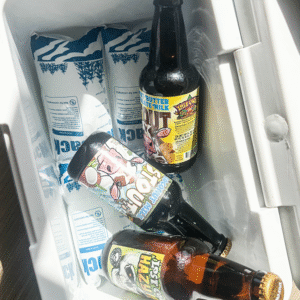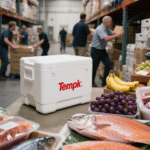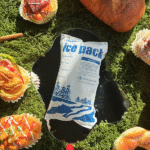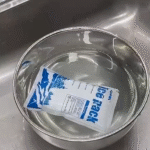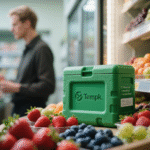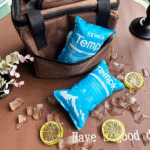Wie man trockenes Eis sicher in einen Kühler einpackt (2025)
Wenn Sie gefrorene Ergebnisse benötigen, Lernen wie man Trockeneis in eine Kühlbox packt the right way is essential. Vorschreibe, Wickelblöcke, eine Barriere hinzufügen, Pack fest, und sicher entlüften. Wenn Sie das tun, bleiben die Lebensmittel 24–72 Stunden lang gefroren, Halten Sie die 2,5-kg-Grenze der Fluggesellschaft ein, und vermeiden Sie rissige Deckel oder durchnässte Verschmutzungen. In diesem Leitfaden werden drei von Ihnen bereitgestellte Entwürfe zu einem 2025-fähigen Artikel zusammengeführt und aktualisiert.
-
How to pack dry ice in a cooler for 24–72 hours with a simple, repeatable method
-
Wie viel Trockeneis Sie tatsächlich benötigen by cooler size and trip length
-
How to pack dry ice in a cooler for flights under the 2.5 kg rule
-
How to pack dry ice in a cooler without freezing drinks using barriers and layout options
-
What to buy (Blöcke vs. Pellets) and how to avoid rapid loss and food burn
How to pack dry ice in a cooler for 24–72 hours?
Kurze Antwort: Kühlen Sie den Kühler vor, wrap dry ice blocks, add a cardboard/divider barrier, pack items tightly, Und halten Sie das Paket entlüftet. Trockeneis auflegen Spitze for the longest frozen hold (kalte Luftwaschbecken); put it under a barrier at the bottom if you want items chilled, nicht gefroren. Gloves and eye protection are non‑negotiable.
Warum es für dich funktioniert: Dry ice is –109 °F (–78,5 ° C.) and turns straight to gas (no melt water). Wrapping reduces surface loss, barriers protect liners and food, and tight packing cuts warm air pockets that “eat” your dry ice. A pre‑chilled cooler plus wrapped blocks can stretch performance from 24 up to ~72 hours depending on size, Wetter, und Deckelöffnungen.
Layouts that simplify how to pack dry ice in a cooler
Top-Pack (max hold): Items → Pappbarriere → wrapped dry ice blocks → close lid
Bodenpackung (easy access): Barriere → wrapped dry ice → barrier → items
Beipack (zwei Zonen): Divider with dry ice on one side; drinks/produce on the other
| Layout Option | Am besten für | Uhrouts | Was es für Sie bedeutet |
|---|---|---|---|
| Top-Pack | Longest frozen hold | Slightly less convenient access | Use for meat, Fisch, ice cream on multi‑day trips |
| Bodenpackung | Mixed “just cold” loads | Shorter frozen hold | Keeps snacks accessible; add water‑ice above barrier |
| Beipack | Split frozen/chilled | Needs a divider | Protects fillets while keeping drinks unfrozen |
Practical tips that save pounds of dry ice
-
Vorschreibe: Load with sacrificial ice overnight; dump it before packing dry ice.
-
Wickeln & Barriere: Newspaper/kraft wrap every block + corrugated sheet to protect liners.
-
Lücken füllen: Towels or frozen bottles remove air pockets and slow sublimation.
-
Shade & shut: Von der Sonne fernhalten; open the lid fast and rarely.
Real -World -Fall: A 55 qt hard cooler, pre‑chilled overnight with a cardboard barrier and a 10 lb top‑pack block, kept ice cream solid for ~36 hours at 88–92 °F with minimal openings.
How to pack dry ice in a cooler: how much do you need?
Faustregel: 5–10 Pfund pro 24h in a well‑insulated hard cooler. Scale up for larger coolers, high heat, frequent access, or flight altitude effects. Many field users plan ~10 lb per 15″ of interior length for deep‑freeze targets over 24–48 h.
Schneller Schätzer (use it in 30 Sekunden)
-
Reiselänge (Tage): D
-
Cooler class multiplier: Small = 1, Medium = 1.5, Large = 2, XL = 3
-
Grundpreis: 7.5 Pfund/24h (midpoint of 5–10 lb)
-
Anpassungen: +25% hot sun; +10% frequent access
Formel: Pounds = D × 7.5 × Class × (1 + Adjustments)
Beispiel: 48 H, Medium, hot sun (+25%), frequent access (+10%) → 2 × 7.5 × 1.5 × 1.35 ≈ 30 lb.
Größentabelle (frozen target)
| Kühlergröße | 24 H | 48 H | Für dich |
|---|---|---|---|
| Klein (20–35qt) | 5–10 Pfund | 10–20lb | Overnight frozen snacks/meat |
| Medium (45–65qt) | 10–15 Pfund | 20–30 Pfund | Wochenendcamping; keep game/fish solid |
| Groß (75–110qt) | 15–25 Pfund | 30–40 Pfund | Multi‑day hunts or outages |
| XL (150 qt+) | 25–40 Pfund | 50–80 lb | Extended runs; verify compatibility |
Estimates assume a hard, dry‑ice‑compatible cooler and tight packing.
How to pack dry ice in a cooler for flights (2025)?
Direkte Antwort: ≤2,5 kg (5.5 lb) pro Passagier/Paket, Entlüftungsverpackung, and “Dry Ice/Carbon Dioxide, solid” marking with net weight. Seek airline approval before travel. Never tape the cooler airtight. Use gel packs to protect items when the dry ice is gone.
Checklist that passes acceptance:
-
Hard cooler that Lüftungsschlitze (gasket/drain cracked per maker guidance)
-
Etikett: "Trockeneis" (oder „Kohlendioxid, solide") + Netzmasse (Z.B., “2.5 kg or less”)
-
Approval: Confirm with your carrier before check‑in
-
Layers: Wickelblöcke + Barriere + enge Packung; minimal air space
-
Carry/Check: Orient to vent; avoid sealed trunks during ground legs
How to pack dry ice in a cooler without freezing drinks?
Barriere + Platzierung + separation. Keep drinks on one side with water‑ice; put wrapped dry ice behind a divider oder on top with a barrier over fragile items. That gives you cold sodas without “freezer‑burn” spots on produce or cheese.
Block vs pellet: what should you buy?
-
Blöcke: Längster Halt; fewer gaps; best for 48–72 h goals
-
Pellets/Nuggets: Faster pulldown; Hohlräume füllen; great as a top‑up around blocks
-
“Airline cuts”: Pre‑sized packs to hit ≤ 2.5 kg when flying
Always wrap and add a barrier either way.
Trockeneis vs. Gelpacks vs. normales Eis (what’s right for you?)
| Verfahren | Typische Temp | Lasts About* | Was es für Sie bedeutet |
|---|---|---|---|
| Trockeneis | –78,5 ° C. (–109°F) | ~18–24 h per 5–10 lb | True frozen hold; no melt water; requires PPE & Entlüftung |
| Gelpackungen | ≈ –18 °C to 0 °C | 12–24H (size/insulation dependent) | Sicherere Handhabung; wiederverwendbar; great for 2–8 °C |
| Normales Eis | 0 ° C (32 ° F) | 4–18h | Billig, einfach; adds water weight and mess |
*Your results vary with insulation, sun, Und wie oft öffnen Sie den Deckel.
User‑friendly safety rules you can’t skip
-
Niemals luftdicht: Gas buildup can bulge lids or rupture containers.
-
Fahrzeuge und Räume lüften: CO₂ is invisible and can displace oxygen; crack windows and avoid sealed trunks.
-
Tragen Sie isolierte Handschuhe und Augenschutz: Prevent frostbite and contact injuries.
-
Dispose in open air: Let leftover dry ice sublimate in a ventilated area—never in sinks or sealed trash.
2025 developments that change how to pack dry ice in a cooler
Was ist neu: Wiederverwendbare Versender, PCM (Phase -Klopfen -Materialien) für 2–8°C-Spuren, Und IoT-Temperaturlogger now complement dry ice. Teams mix VIP -Panels + PCMs to shrink dry‑ice mass, Abfall reduzieren, and monitor in real time. CO₂ supply dynamics still affect regional availability, so plan purchases ahead in peak seasons.
Letztes auf einen Blick
-
Reusable systems rising: Less EPS waste, lower long‑term cost
-
Intelligente Überwachung: App‑connected loggers flag temperature drift early
-
VIP + PCM combos: Smaller packs, ständigere Temperaturen, weniger Ausflüge
Market insight: Expect steady growth in cold‑chain packaging and monitoring through the late 2020s. Für dich, that means more options to combine dry ice with PCMs and loggers for greener, safer trips.
FAQ
Wie lange dauert Trockeis in einem Kühler??
In a good hard cooler, planen 5–10 lb for ~24 h. Heat and frequent openings shorten that; pre‑chill and tight packing extend it.
Where should dry ice go—top or bottom?
Top for frozen results (Kaltes Waschbecken). Bottom under a barrier if you just want “cold, not frozen.”
Can I fly with dry ice in my cooler?
Ja-≤2,5 kg (5.5 lb) pro Passagier/Paket, entlüftet, beschriftet, and approved by the airline.
Will dry ice crack my cooler?
Use a dry‑ice‑rated hard cooler and add a Barriere. Many soft coolers are nicht rated.
Ist Trockeneis im Auto sicher??
Yes with Belüftung. Crack windows and avoid sealed cabins during long legs.
Actionable tools
2‑minute “Do I need dry ice?” self‑check
-
Goal frozen solid ≥24 h? Wenn ja, Verwenden Sie Trockeneis; if no, use PCMs/gel packs.
-
Open lid ≥1×/hr? Hinzufügen +10% Trockeneis.
-
Hot sun > 90 ° F.? Hinzufügen +25% dry ice and shade the cooler.
-
Gemischte Last? Side‑pack with a divider; Getränke + water‑ice on the warm side.
Copy‑and‑use packing checklist (print for your lid)
-
Verify cooler is dry‑ice compatible
-
Vorschreibe 12–24H
-
Planen Pfund with the quick estimator
-
Wickelblöcke + hinzufügen Barriere
-
Pack fest; fill all air gaps
-
Entlüftung (crack drain/lid per maker)
-
Überwachen Sie die Temperaturen (≤ 40 °F for food; ≤ 0 °F for frozen items)
-
Sicher entsorgen in open air
Über Tempk
We help teams move temperature‑sensitive goods safely and simply. Unsere wiederverwendbaren Versender, PCM -Packungen, and connected loggers are validated to cut excursions and speed pack‑outs. Kunden berichten fewer repacks Und hält länger with our standard kits. Talk to us about a dry ice or PCM setup for your lanes—we’ll turn this guide into your SOP.






